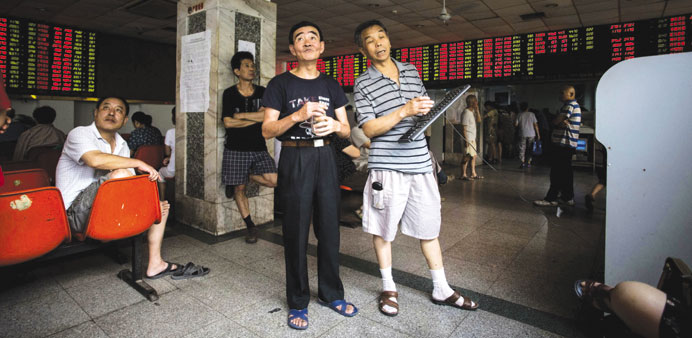Investors monitoring stock market movements at a brokerage house in Shanghai. Chinese shares closed up 0.07% yesterday and ended the week higher for the first time since mid-August.
AFP/Tokyo
Asian markets mostly slipped yesterday but ended a volatile week in relative calm after China unveiled a series of steps to shore up its economy and reassure investors, but fears of a US interest rate hike kept nerves on edge.
Higher-yielding, or riskier, currencies such as the Malaysian ringgit and South Korean won benefited from a more upbeat outlook, which followed a positive lead from Wall Street, while the Australian dollar edged higher.
The safe-haven yen, considered a go-to asset in times of turmoil, retreated.
Analysts said world markets seemed to be settling after a roller-coaster ride since China last month devalued its yuan currency, sparking concerns about the world’s number two economy—the main driver of global growth—and its leaders’ ability to control the crisis.
The broadly upbeat sentiment comes after Beijing sought to reassure investors it was able to maintain high growth, and announced a plan to speed up major construction projects and cut taxes for small and medium-sized enterprises. A set of capital controls to prevent a flight of cash were implemented this week, while analysts said a rise in the offshore yuan Thursday suggested the central bank had intervened to prop it up. China is to release data on sales and investment on Sunday.
Authorities also unveiled a series of measures to prevent huge swings in China’s stock markets, which have seen trillions of dollars wiped off valuations in Shanghai since it hit a peak in mid-June. Among the measures are a “circuit breaker” that stops shares being traded after rising or falling by a certain amount.
Shanghai closed up 0.07% and ended the week higher for the first time since mid-August. But Hong Kong dropped 0.27% and Sydney edged 0.47% lower by the end.
Tokyo eased 0.19%. Wild swings during the week included a 7.7% surge Wednesday followed by a 2.5% fall Thursday. But the index ended the week up from last Friday’s close.
Juichi Wako, a senior strategist at Nomura Holdings, told Bloomberg News: “We seem to be forming a bottom, but uncertainty has yet to be completely dispelled, including what happens with US monetary policy.”
Global investors are nervously waiting for next week’s Federal Reserve policy meeting, with uncertainty over whether it will lift interest rates for the first time in nine years or hold fire owing to the recent market turmoil.
A hike in borrowing costs would likely hinder investment possibilities and also fan a flight of capital back to the US in search of better returns, to the detriment of emerging markets.
Hopes that bank policymakers will opt not to raise rates supported US stocks, with Wall Street’s three main indexes all ending strongly higher.
A less volatile atmosphere saw low-risk assets retreat. The dollar bought ¥120.75 compared with ¥120.63 in New York, while the euro was at ¥136.15 compared with ¥136.01. The single currency also rose to $1.1282 from $1.1275.
And the Australian dollar, which earlier in the week hit a six-year low below 69 US cents, was at 70.68 cents.
The ringgit was up 0.27% and the won gained 0.83%, helped by the Bank of Korea’s decision not to cut borrowing rates. And New Zealand’s dollar, which tanked Thursday after its central bank cut interest rates, edged up 0.35%. There were also gains for the Indian rupee and Thai baht.



